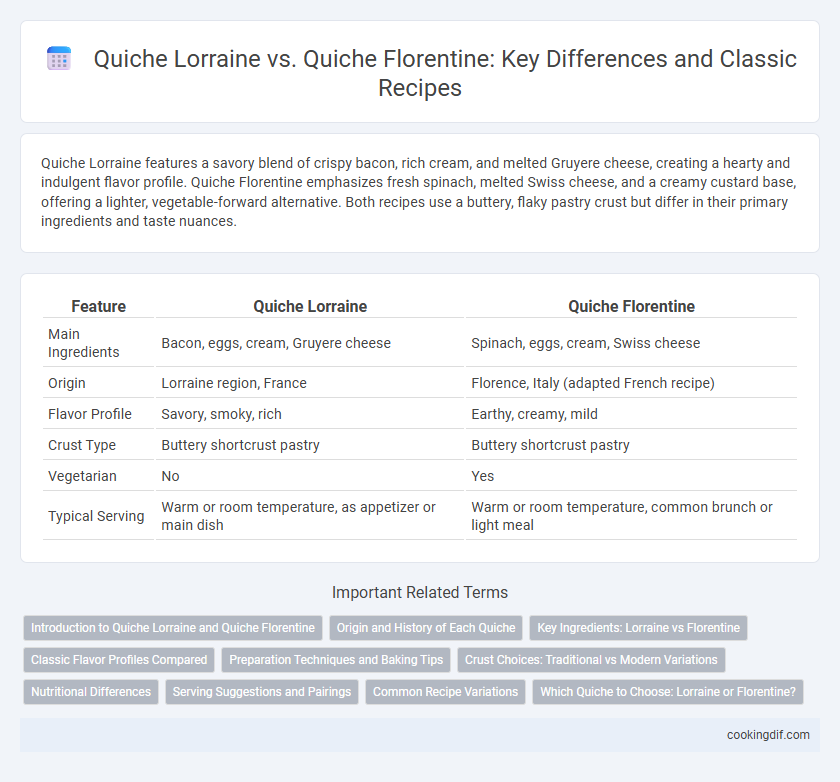Quiche Lorraine features a savory blend of crispy bacon, rich cream, and melted Gruyere cheese, creating a hearty and indulgent flavor profile. Quiche Florentine emphasizes fresh spinach, melted Swiss cheese, and a creamy custard base, offering a lighter, vegetable-forward alternative. Both recipes use a buttery, flaky pastry crust but differ in their primary ingredients and taste nuances.
Table of Comparison
| Feature | Quiche Lorraine | Quiche Florentine |
|---|---|---|
| Main Ingredients | Bacon, eggs, cream, Gruyere cheese | Spinach, eggs, cream, Swiss cheese |
| Origin | Lorraine region, France | Florence, Italy (adapted French recipe) |
| Flavor Profile | Savory, smoky, rich | Earthy, creamy, mild |
| Crust Type | Buttery shortcrust pastry | Buttery shortcrust pastry |
| Vegetarian | No | Yes |
| Typical Serving | Warm or room temperature, as appetizer or main dish | Warm or room temperature, common brunch or light meal |
Introduction to Quiche Lorraine and Quiche Florentine
Quiche Lorraine features a savory custard filling with smoky bacon, eggs, and creamy Swiss or Gruyere cheese, creating a rich and traditional French tart. Quiche Florentine highlights tender spinach blended with eggs, cheese, and occasionally garlic or onions, delivering a lighter, vegetable-focused flavor profile. Both recipes use a flaky pastry crust, showcasing distinct regional ingredients and culinary styles in classic French cuisine.
Origin and History of Each Quiche
Quiche Lorraine, originating from the Lorraine region of France, traditionally features a savory custard filled with bacon, eggs, and cream, dating back to the 16th century as a rural French dish. Quiche Florentine, inspired by Florence, Italy, incorporates spinach alongside eggs and cheese, reflecting Tuscan culinary traditions that emphasize fresh greens and simple, hearty flavors. Both recipes highlight regional ingredients and cultural influences, with Quiche Lorraine representing French rustic cuisine and Quiche Florentine showcasing Italian variations on the classic quiche concept.
Key Ingredients: Lorraine vs Florentine
Quiche Lorraine features a rich custard with key ingredients such as eggs, heavy cream, crispy bacon or lardons, and Gruyere cheese, creating a savory and smoky flavor profile. Quiche Florentine highlights fresh spinach, eggs, cream, and often Gruyere or Parmesan cheese, emphasizing a lighter, vegetable-forward taste. The main distinction lies in the Lorraine's inclusion of pork and the Florentine's focus on leafy greens, each delivering a unique regional taste from French cuisine.
Classic Flavor Profiles Compared
Quiche Lorraine features a rich blend of smoky bacon, creamy custard, and Gruyere cheese, creating a savory and indulgent flavor profile. Quiche Florentine centers on fresh spinach and nutmeg, combined with eggs and Swiss cheese, offering a lighter, earthier taste. Both recipes rely on a buttery pastry crust that enhances the overall texture and balances their distinct ingredients.
Preparation Techniques and Baking Tips
Quiche Lorraine features a custard filling with bacon and Gruyere cheese, requiring precooked bacon to prevent sogginess and blind baking the crust to maintain firmness. Quiche Florentine incorporates spinach into the egg mixture, often sauteed and well-drained to avoid excess moisture that can compromise crust texture. Both recipes benefit from baking at 350degF (175degC) until the custard sets but remains slightly jiggly to ensure a creamy interior without overcooking.
Crust Choices: Traditional vs Modern Variations
Quiche Lorraine features a classic buttery, flaky pastry crust that enhances its rich, savory custard filled with bacon and Gruyere cheese, emphasizing traditional French baking techniques. In contrast, Quiche Florentine often embraces modern variations such as whole wheat or gluten-free crusts, catering to health-conscious or dietary preferences while still supporting the spinach and cheese filling. These crust choices impact the texture and flavor profile, offering either a heritage culinary experience or a contemporary twist on this beloved savory pie.
Nutritional Differences
Quiche Lorraine typically contains bacon, eggs, and cheese, resulting in higher protein and saturated fat content, while Quiche Florentine incorporates spinach, eggs, and cheese, providing more dietary fiber, vitamins A and K, and antioxidants. Quiche Florentine tends to have fewer calories and less cholesterol compared to the richer Quiche Lorraine due to its vegetable base. Both quiches offer essential nutrients but differ significantly in fat composition and micronutrient profiles, influencing their nutritional impact.
Serving Suggestions and Pairings
Quiche Lorraine traditionally pairs well with a crisp green salad dressed in vinaigrette, enhancing its rich, savory flavors of bacon and Gruyere cheese. Quiche Florentine, featuring spinach and Swiss cheese, complements light side dishes such as fresh tomato slices or roasted asparagus, balancing its creamy texture with fresh, earthy notes. Both quiches benefit from a chilled glass of dry white wine like Sauvignon Blanc or a light Pinot Noir to accentuate their distinct flavor profiles.
Common Recipe Variations
Quiche Lorraine typically features a savory custard with bacon, eggs, cream, and Gruyere cheese, offering a rich and smoky flavor profile. Quiche Florentine incorporates fresh spinach or Swiss chard in the custard base, combined with eggs, cream, and often Gruyere or Parmesan cheese, creating a lighter, vegetable-forward dish. Common recipe variations include substituting bacon with pancetta or ham in Lorraine and adding nutmeg or garlic to enhance the spinach aroma in Florentine.
Which Quiche to Choose: Lorraine or Florentine?
Quiche Lorraine features a rich custard base with crispy bacon and Gruyere cheese, delivering a classic, savory flavor perfect for those preferring traditional French cuisine. Quiche Florentine incorporates fresh spinach and often includes nutmeg and Parmesan, offering a lighter, vegetable-forward option that appeals to health-conscious individuals. Choosing between Lorraine and Florentine depends on whether you desire a hearty, indulgent dish or a nutrient-rich, green-based quiche.
quiche Lorraine vs quiche Florentine recipes Infographic

 cookingdif.com
cookingdif.com